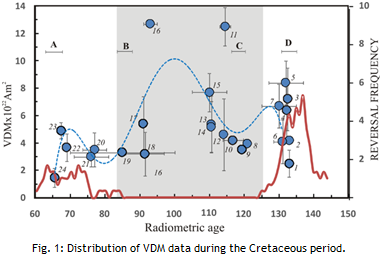 Knowledge about long-term variation of the geomagnetic dipole field remains in its nascent stage because of the paucity of reliable experimental data over geological periods. Here, we present the first robust experimental data from the largest Cretaceous flood basalt province on Earth, the ~65–66 Ma Deccan basalt within a thick (1250 m) unbiased stratigraphic section down to the basement, recovered from a drill hole of the Koyna Deep Scientific Drilling Project in the Western Ghats, India. Critical analysis of the result along with similar results of the Cretaceous age find that (i) the dipole moment during the end Cretaceous Deccan eruption is the lowest in whole of Cretaceous (ii) dipole moment at the onset/termination of the Cretaceous Normal Superchron is apparently lower relative to that in mid-superchron, however, such differences cannot be deciphered in shorter polarities probably because of insufficient time to develop recognizable variations (iii) inverse relation between dipole moment and reversal rate is lacking and (iv) a cause and effect relation between core-mantle boundary heat flux and low dipole moment that appears to be the principle governing factor in forming the Large Igneous Provinces on the surface of earth.
Knowledge about long-term variation of the geomagnetic dipole field remains in its nascent stage because of the paucity of reliable experimental data over geological periods. Here, we present the first robust experimental data from the largest Cretaceous flood basalt province on Earth, the ~65–66 Ma Deccan basalt within a thick (1250 m) unbiased stratigraphic section down to the basement, recovered from a drill hole of the Koyna Deep Scientific Drilling Project in the Western Ghats, India. Critical analysis of the result along with similar results of the Cretaceous age find that (i) the dipole moment during the end Cretaceous Deccan eruption is the lowest in whole of Cretaceous (ii) dipole moment at the onset/termination of the Cretaceous Normal Superchron is apparently lower relative to that in mid-superchron, however, such differences cannot be deciphered in shorter polarities probably because of insufficient time to develop recognizable variations (iii) inverse relation between dipole moment and reversal rate is lacking and (iv) a cause and effect relation between core-mantle boundary heat flux and low dipole moment that appears to be the principle governing factor in forming the Large Igneous Provinces on the surface of earth.
Bibliographic Info: Radhakrishna, T., Asanulla R. Mohamed, Venkateshwarlu, M., Soumya, G. S. [2020]. Low geomagnetic field strength during End-Cretaceous Deccan volcanism and whole mantle convection. Scientific Reports, Vol. 10 (1), Art. 10743. https://doi.org/10.1038/s41598-020-67245-6




 RTI Act
RTI Act
